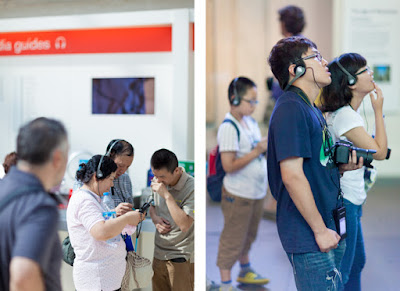 |
| Photo (c) Metropolitan Museum |
And yet. When I visit a museum, I am always torn as to whether or not I should use the audio guide. One one hand, I don't want to miss anything. On the other hand, I don't want a stranger to tell me what to see, or what to think about the works of art.
The Metropolitan Museum in New York did a comprehensive study of its audioguide program in 2015. The study found that
80% of the museum visitors thought that the audioguides helped them look more closely at the art, and fostered a greater sense of connection and engagement. That's a pretty compelling finding. Other studies aren't quite so encouraging.
I found a number of other studies commissioned by museums to assess their audio guides. Among other things, the studies identify factors that affect whether or not visitors take an audio guide. Key factors include how much time the visitors have; how confident they are of finding things themselves; and whether they prefer self-determination, or instead are willing to submit to the authority of the audio guide. Hmmmm.
The studies I found failed to mention a key factor that often deters me from using the audio guide: the guide causes major traffic jams around the paintings or objects that are highlighted for discussion. So frustrating! I'd rather be able to enjoy a lesser known work, without having my toes stepped on, than be uncomfortably jostled in front of a masterpiece.
I guess I sometimes fall into the stubborn class, whose members don't like to submit to authority! Perhaps, as painters, we are outliers in the audio guide choice. I would love to hear from others--what do you think about using audio guides?
The Metropolitan Museum in New York did a comprehensive study of its audioguide program in 2015. The study found that
80% of the museum visitors thought that the audioguides helped them look more closely at the art, and fostered a greater sense of connection and engagement. That's a pretty compelling finding. Other studies aren't quite so encouraging.
I found a number of other studies commissioned by museums to assess their audio guides. Among other things, the studies identify factors that affect whether or not visitors take an audio guide. Key factors include how much time the visitors have; how confident they are of finding things themselves; and whether they prefer self-determination, or instead are willing to submit to the authority of the audio guide. Hmmmm.
The studies I found failed to mention a key factor that often deters me from using the audio guide: the guide causes major traffic jams around the paintings or objects that are highlighted for discussion. So frustrating! I'd rather be able to enjoy a lesser known work, without having my toes stepped on, than be uncomfortably jostled in front of a masterpiece.
I guess I sometimes fall into the stubborn class, whose members don't like to submit to authority! Perhaps, as painters, we are outliers in the audio guide choice. I would love to hear from others--what do you think about using audio guides?



No comments:
Post a Comment